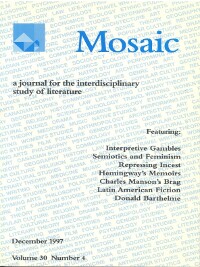Issue 30.4
Overview

General Issue
Published: December 1997
View the issue introduction or see the issue summary and contents below.
7 essays, totalling 140 pages
$15.00 CAD
Uneasy or unexpected identity formation is central to many of the essays in this general issue of Mosaic. It contains essays on identity in Ernest Hemingway’s memoirs, repressed incestuous rape in William Faulkner’s Sanctuary, fabrication metaphor and Charles Manson, and Latin American literature and the social imaginary. The three other essays in the issue focus on matters of literary interpretation and language in two early modern lyrics and Donald Barthelme’s contemporary reimagining of Snow White.
Jeremy Bentham’s Wager, The Game of Reading, and “Westron wind”Franklin E. Court The meaning and significance of the anonymous lyric, “Westron wind,” can be enhanced, especially for classroom use, by risking a Benthamite “deep play.” The gamble, an exercise in reader-response, provides the lyric with a speculative but reasonably plausible context that increases its literary appeal. The “deep play” also encourages interdisciplinary research since it necessitates what Stephen Jay Gould refers to as “replaying the tapes of history” with an eye toward recovering originary historical particulars lost to time. | |
Discourse Analysis and Literary Study: Aemilia Lanyer’s “Epistle” as Sample TextLouise Schleiner The speech and writing in and around an institution or set of institutions can be termed a discourse domain: a permeable and self-revising system that, at any given time, offers genres, reception practices, and gendered subject positions for its participants. In these terms, Aemilia Lanyer’s “Epistle” from Salve Deus Rex Iudaeorum (1611) is used to highlight the importance of semiotic discourse analysis for literary scholarship. | |
Incest, Repression, and Repetition-Compulsion: The Case of Faulkner’s Temple DrakeKathleen M. Scheel Using psychoanalytic theories about repression and repetition-compulsion, this essay argues that the real mystery of William Faulkner’s Sanctuary is not the rape of Temple Drake at the Old Frenchman place, but her incestuous rape at home, which occurs antecedent to events mentioned in the novel. | |
The Normalization of Authenticity: Marshall Field, Emily Post, and the Memoirs of Ernest HemingwayCharles Harmon The memoirs of Ernest Hemingway reveal a middle-class subject dwelling in a cultural gulf between avant-garde authenticity and middle-class normality. As such, they indicate that high and mass culture were neither antithetical nor identical but, instead, complementary resources in the larger product of modern identity-construction. | |
“I Am What You Made Me”: The Fabrication Metaphor and Its SignificanceStewart Justman Commonly enough we speak of others—not ourselves—as the products of shaping forces. What does it mean to speak of the production of a person? Using the Manson case as a point of departure, this essay examines the effect of the fabrication metaphor on how we conceive and enact relations to the other. | |
The Social Imaginary/Symbolic: Technology and Latin American LiteratureJerry Hoeg This essay examines the relationships between the Social Imaginary, modern technology and Latin American literature. The goal of this investigation is that of evaluating the possible influence of literature in transforming the Social Imaginary and hence the discourses mediated by it, especially the dominating versions of the discourses of science and technology. | |
Heteroglossia and Collage: Donald Barthelme’s Snow WhiteNicholas Sloboda As a means to a better understanding of Barthelme’s textual strategy in Snow White, Mikhail Bakhtin’s sociologic reading of language alongside W.J.T. Mitchell’s reconsideration of iconology provide useful conceptual horizons. Enlisting them, this essay attempts to initiate the formation of a hermeneutic model that can address Barthelme’s unique playful and postmodern destabilization of word, image, and subjectivity. |